| Revision as of 15:04, 31 December 2008 editTenOfAllTrades (talk | contribs)Administrators21,283 edits →Plagiarism: removed block of copied text to talk page. Please paraphrase or footnote and quote as appropriate.← Previous edit | Revision as of 19:24, 31 December 2008 edit undoTenOfAllTrades (talk | contribs)Administrators21,283 edits →Plagiarism: Explain once more why the text can't go back until it's fixed.Next edit → | ||
| Line 107: | Line 107: | ||
| :As I noted above, the block of text appears to be mostly image captions copied from . Someone with advanced Google skills may want to look for the report in a prettier format. ](]) 15:04, 31 December 2008 (UTC) | :As I noted above, the block of text appears to be mostly image captions copied from . Someone with advanced Google skills may want to look for the report in a prettier format. ](]) 15:04, 31 December 2008 (UTC) | ||
| :I have again removed the block of copied text. ''Please'' don't restore it to the article until the quotations are clearly marked (with "double quotes") and footnoted, or the passages are paraphrased (and footnoted). Shustov, while the images in the article have correct source information on their description pages, the article ''text'' does not. Until that text – which contains many blocks of material drawn ''verbatim'' from USGS sources – is corrected, it can't go back in the article. ](]) 19:24, 31 December 2008 (UTC) | |||
Revision as of 19:24, 31 December 2008
| Earthquakes B‑class | ||||||||||
| ||||||||||
| Civil engineering Stub‑class High‑importance | ||||||||||
| ||||||||||
| This article is written in British English, which has its own spelling conventions (colour, travelled, centre, defence, artefact, analyse) and some terms that are used in it may be different or absent from other varieties of English. According to the relevant style guide, this should not be changed without broad consensus. |
|
|
Earthquake engineering / seismic analysis / seismic performance
Misplaced Pages's content on earthquake engineering is currently a bit of a mess. I am going to try to clear it up (but it might take me a while). Earthquake engineering includes analysis and design. Currently there is a reasonably decent article on analysis, and several articles on design which all seem to push the same approach and one product in particular (Earthquake Performance Evalunation Tool).
I have created this as a separate article, and propose to merge several articles into this one so that there is one clear and concise article on earthquake engineering. The Seismic analysis article can then remain as a more detailed article on analysis, which is probably the largest single topic.Tkn20 (talk) 10:51, 1 June 2008 (UTC)
Merger Proposal
I propose to merge:
- Seismic performance
- Vibration control
- Earthquake construction
- Earthquake Performance Evaluation Tool
- Earthquake Protector
- Earthquake simulation
into this article. The last three are in my opinion just adverts for particular products, and may be original research (so there is little to merge, but some of the content would be relevant when included with other available research and products). This is a big topic, covered very badly with several articles giving only a tiny view of the whole. The best thing to do is to start with a good overall article.
In the case of vibration control - there is perhaps a good argument to keep a vibration control article, but it shouldn't be primarily about earthquake vibration as it currently is. Vibration is caused in machines, by pedestrians, cars, wind and all sorts of other causes. The vibration control article should be much more general, and the earthquake specifics merged into this article. Tkn20 (talk) 10:56, 1 June 2008 (UTC)
Article Earthquake engineering now contains all basic information from six (6) articles recommended for merging which should be redirected to the following sections and subsections of Earthquake engineering:
- Seismic performance to 1 Seismic performance
- Seismic Performance Evaluation Tool to 1.1 Seismic performance evaluation
- Earthquake simulation to 2.2 Earthquake simulation
- Vibration control to 3 Seismic vibration control
- Earthquake Protector to 3.1 Earthquake protector
- Earthquake construction to 5 Earthquake construction
Shustov (talk) 22:12, 25 June 2008 (UTC)
list in intro
It does not bother me much, but is there a reason for the list of "main objectives of earthquake engineering" in the into is presented in list form, rather than prose? It's not hideous, but does not seem necessary. WP:EMBED perhaps has some insight? Again, not a huge deal to me, just seems like it might be better. ./zro (⠠⠵) 05:08, 23 December 2008 (UTC)
If it does not bother you too much, why should we scratch it? Anyway, the list format of presenting the main objectives of earthquake engineering seems to me more visual, easy for viewing and, therefore, should be preferred where appropriate. Best, Shustov (talk) 09:12, 23 December 2008 (UTC)
Plagiarism
It looks like there are blocks of text in this article which are word-for-word copies of outside works. In Earthquake engineering#Failure modes, a number of the image captions are drawn directly from USGS documents (e.g. ) without attribution. (That section needs some cleanup in any case.) Footnotes, people! TenOfAllTrades(talk) 15:28, 28 December 2008 (UTC)
- Dear TenOfAllTrades: Though you, according to your User resume, are "intimately acquainted with the use of semicolons", please, think twice before accusing me in plagiarism in Earthquake engineering. All images in this article - among them there are 12 of my own - have been properly credited. In particular, of 14 images from the section Earthquake engineering#Failure modes, 7 were diligently credited to USGS (to verify, just click on the pictures!). Besides, I provided an external link to USGS site, see USGS Earthquake Hazards Program. Keep clear! Shustov (talk) 10:10, 30 December 2008 (UTC)
- Shustov, it may be that you're unfamiliar with the normal rules and standards for citations in scholarly works. While I'm sure that you're doing so unintentionally, breaking those rules is plagiarism, and is something that has to be taken very seriously. Let me try to give you a condensed quick reference guide to how you can avoid problems in the future (and how you can fix the text you've already added).
- When you copy a source word-for-word, it is essential that you do two things. You must enclose the copied material in double quotations marks: "like this". It should be absolutely clear which text you wrote yourself, and which text came from another author. Second, you need to clearly identify the source for any material which you've copied. Every quoted passage needs to have a citation identifying its source. (See Misplaced Pages:Citing sources#When quoting someone.)
- It isn't sufficient to include a single link in the Bibliography or External Links section. That doesn't tell our reader which text was not written by Misplaced Pages editors, and so fails to give credit where it is due. It also doesn't allow anyone to come back and verify the correctness of the quotations; no one knows what content from the article – if any – is drawn from any particular linked page. Finally, the particular link that you've given above only links to a large directory of additional documents and resources. While it may be a valuable resource suitable for inclusion in the list of External Links, it doesn't contain the text that was copied, again making it difficult to locate the original source of the material.
- For the USGS images which you've uploaded, yes — you have given appropriate credit on the image description pages. In the future, there are some additional tricks which you (and other Misplaced Pages editors) might find useful. There's a number of things you can add to the image description page.
- You can include a link (URL) for the online source of the image. Not only does that make it easy for subsequent editors to verify the source, it may also provide a useful resource to future editors.
- For images which are part of a larger document, including full publication details (title, author(s), date, etc.) can be helpful. Links to online documents are again helpful.
- For public domain technical images which are captioned, consider copying the caption in its entirety on to the image description page. (Citation rules apply there as everywhere else, so be sure to enclose the caption in "double quotes" and indicate explicitly the source.) Feel free to add additional descriptive material as appropriate.
- I hope that you find some of that guidance worthwhile, and that you can use it to fix up your contributions. TenOfAllTrades(talk) 14:24, 30 December 2008 (UTC)
Dear TenOfAllTrades: you persistently demonstrate obsession with the fixed idea of my plagiarism in the article Earthquake engineering. Unfortunately, I am a Doctor in earthquake engineering and not in medicine. However, if you wish to recover soon, please, try the following:
- Forget about earthquake engineering for a while, relax and take a deep breath.
- Try to recollect something nice and very simple: e.g., that you are "intimately acquainted with the use of semicolons" (citation from your User resume).
- Then, to warm up, do a few of my lovely sit-ups like this: File:UPSTREAM FITNESS-1.jpg.
- Most likely, after you went through the previous step, "you need to clean up after yourself" (citation from your talk on Earthquake engineering of 01:34, 30 December 2008 (UTC)).
If you are still warm and looking forward to accuse me in stealing “blocks of text which are direct copies of USGS documents” (citation from your talk on Earthquake engineering of 16:46, 29 December 2008 (UTC)), please, be advised that USGS, according to its mission statement (see USGS#Mission), is the agency which stays far away from the field of Earthquake engineering and, therefore, there is nothing valuable for me to steal from them. You may, also, compare the Categories for USGS and Earthquake engineering articles: absolutely no correlation! Due to this, your allegation that “a number of the image captions are drawn directly from USGS documents (e.g. ) without attribution” (citation from your talk on Earthquake engineering of 15:28, 28 December 2008 (UTC)) holds no water. Again, as I stated before, of the total of 14 images from the section Earthquake engineering#Failure modes, 7 were diligently credited to USGS (to verify, just click on the pictures!). Besides, I provided an external link to USGS site, see USGS Earthquake Hazards Program (talk of 10:10, 30 December 2008 (UTC)). By the way, I do not have any exclusive rights for editing Earthquake engineering. If anybody feels able to do the job, pull up your panties and go ahead! My best New Year wishes to all Wikipedians! Shustov (talk) 03:25, 31 December 2008 (UTC)
- So far, I've only looked at the section on 'failure modes'. I'm moving the bulk of the section to this talk page (below) and I hope that someone can fix it up – making appropriate use of quotation marks and footnotes, and paraphrasing and summarizing as necessary – before it goes back into the article. (While portions of the text here may be original, leaving those fragments in the article would be confusing.)
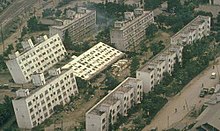
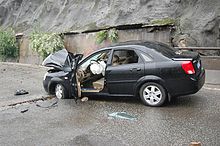
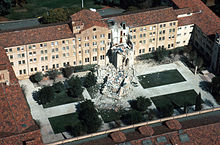
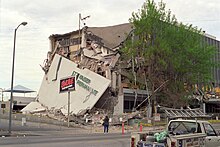
- Improper construction site
- Poor detailing of the reinforcement ( lack of concrete confinement in the columns and at the beam-column joints, inadequate splice length)
- Weak/soft story (open space at the first floors)
- Long cantilevers with heavy load

If a superstructure is not mounted on a base isolation system, its shifting on the basement should be prevented.



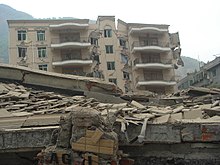

- As I noted above, the block of text appears to be mostly image captions copied from this USGS report. Someone with advanced Google skills may want to look for the report in a prettier format. TenOfAllTrades(talk) 15:04, 31 December 2008 (UTC)
- I have again removed the block of copied text. Please don't restore it to the article until the quotations are clearly marked (with "double quotes") and footnoted, or the passages are paraphrased (and footnoted). Shustov, while the images in the article have correct source information on their description pages, the article text does not. Until that text – which contains many blocks of material drawn verbatim from USGS sources – is corrected, it can't go back in the article. TenOfAllTrades(talk) 19:24, 31 December 2008 (UTC)
- B-Class WikiProject Earthquakes articles
- Unknown-importance WikiProject Earthquakes articles
- WikiProject Earthquakes articles
- Stub-Class Civil engineering articles
- High-importance Civil engineering articles
- WikiProject Civil engineering articles
- Misplaced Pages articles that use British English
- Misplaced Pages pages with to-do lists

